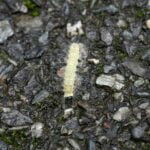Curiosity about the natural world often leads us to discover fascinating creatures and their intriguing behaviors. One such curiosity that frequently arises is whether centipedes bite. As an experienced entomologist specializing in arthropods, I have delved deep into the world of these multi-legged creatures and their bites. In this article, titled “Centipede Bites: Facts, Prevention, and Treatment,” I aim to provide you with valuable insights on the topic. From debunking common misconceptions to identifying different species of centipedes and analyzing their venomous capabilities, I will equip you with essential knowledge. Moreover, I will offer practical tips on how to prevent centipede encounters and how to treat their bites effectively. So, let’s embark on this enthralling journey into the world of centipedes and unravel the truth behind their bites.

Do Centipedes Bite?
Centipedes: those creepy-crawly creatures with their numerous legs and swift movements. Many people shudder at the mere thought of them, and with good reason. But let’s address the burning question that often arises when it comes to centipedes: do centipedes bite? The short answer is yes, some species of centipedes are capable of biting, including the common brown house centipede.
When it comes to centipedes, it’s important to understand that they have venomous jaws called forcipules. These forcipules are not teeth, but rather modified legs resembling claws or pincers located near their heads. These forelegs are filled with venom, which centipedes use to immobilize their prey. So, when a centipede bites, it’s not a pleasant experience. However, you’ll be relieved to know that centipede bites are generally not serious and symptoms tend to improve within a couple of days.
Identifying Different Species of Centipedes
To gain a better understanding of centipede bites, it’s crucial to recognize the various species. Centipedes come in different shapes, sizes, and colors, with some having venomous capabilities. The common brown house centipede is the typical culprit when it comes to biting humans. With their long legs and distinctive appearance, these insects often evoke feelings of unease and discomfort.
But what about other species? Some centipedes are harmless to humans and play an important role in our ecosystem. They prey on insects, helping to control populations and maintain balance in nature. However, there are a few species out there that are venomous and can deliver a painful bite. These include the giant desert centipede, the Texas red-headed centipede, and the blue ring centipede, to name a few. So, if you come across a centipede, it’s best to observe it from a safe distance rather than risk getting too close and potentially being bitten.
The Effects of Centipede Bites
Okay, so we’ve established that centipedes do bite, but what can you expect if you’re unfortunate enough to experience a bite? Well, first and foremost, it’s essential to note that centipede bites are rare in humans. However, if you do find yourself on the receiving end of a centipede’s bite, you may experience varying degrees of pain, ranging from mild to moderate. Think of it as a sharp sting or a burn, similar to a wasp or bee sting.
While the pain can be intense, the good news is that centipede bites in most cases do not cause any long-term damage. Symptoms typically improve within a couple of days, and there is usually no need for medical intervention. However, it’s crucial to seek medical attention if you experience severe pain or an allergic reaction to the bite.
Prevention and Treatment of Centipede Bites
Now that we understand the potential effects of centipede bites, let’s discuss practical tips for prevention and treatment. When it comes to preventing centipede bites, keeping your home clean and free from clutter is key. Centipedes are attracted to dark and damp environments, so reducing moisture levels and sealing any cracks or openings in your home can help keep them at bay.
If you do encounter a centipede, it’s best to avoid handling it. Remember, they have those venomous jaws that they’re not afraid to use. Instead, calmly remove yourself from the area and allow the centipede to continue on its way.
In the unfortunate event of a centipede bite, there are a few steps you can take for treatment. Start by cleaning the wound with mild soap and water to reduce the risk of infection. Apply a cold compress or ice pack to the bite area to alleviate any pain or swelling. Over-the-counter pain relievers, such as ibuprofen or acetaminophen, can also help manage discomfort.
In conclusion, while centipede bites can be painful in the moment, they are usually not serious and symptoms generally improve within a couple of days. It’s important to remember that centipedes play a significant role in our ecosystem, and most of them are harmless to humans. By understanding the different species of centipedes, practicing prevention methods, and knowing how to treat a bite if it occurs, you can coexist with these fascinating creatures without undue fear or concern.
“Centipedes may be creepy, but their bites are usually not cause for alarm. With the right knowledge on prevention and treatment, you can navigate centipede encounters with confidence.”
Centipedes are fascinating creatures with a multitude of intriguing characteristics. Did you know that they have an astonishing number of legs, ranging from 30 to over 300? If you’re curious to learn more interesting facts about centipedes, click here to explore their world: interesting facts about centipedes. Prepare to be amazed by the astonishing abilities and unique adaptations of these remarkable arthropods.
Article Section:
[youtube v=”-6vzjjIrRK8″]
The Giant Desert Centipede: A Bite Worse Than All Stings?
Introduction:
There are few creatures on this planet that strike fear into the hearts of humans quite like the giant desert centipede. Dormant during the day and a fearsome predator by night, this leggy creature is adorned with venomous fangs that instill terror in the bravest of souls. In this article, we will delve into the daring encounter between wildlife enthusiast Coyote Peterson and the giant desert centipede, exploring the immense pain and discomfort he endured in the pursuit of knowledge and understanding.
The Toe Biter: A Challenge Conquered:
Before we dive into the terrifying world of the giant desert centipede, it is essential to touch upon another formidable creature that holds a place of fear in the heart of Coyote Peterson – the toe biter, scientifically known as the giant water bug. Tasked with facing this creature’s bite, Coyote emerged victorious, conquering the pain and transforming it into a valuable learning experience. Driven by his dedication to education and a desire to shed light on misunderstood creatures, Coyote welcomed the opportunity to experience and document the pain inflicted by these creatures.
Enter the Giant Desert Centipede:
The giant desert centipede, an arthropod classified as a myriapod, is the largest centipede species found in the United States. With its nocturnal habits and lightning-fast movements, encountering one is a spine-chilling experience. Whether witnessed in broad daylight or under the cover of darkness, this leg-covered, venomous predator is a nightmare come to life. Coyote, known for his audacious pursuits, finally gave in to the numerous requests from his audience and decided to face this formidable creature.
The Encounter:
In a nerve-racking moment, Coyote cautiously approached the giant desert centipede, which he had captured the previous night. With the creature secured in a container, he braced himself for what lay ahead. Although part of him was driven by curiosity and eagerness to understand the true impact of the bite, another part couldn’t help but feel a deep sense of dread and fear.
The Bite:
The time had come. Coyote, realizing that there was no escaping the inevitable, made the bold decision to allow the giant desert centipede to sink its venomous fangs into his flesh. As the creature clamped onto his arm, the excruciating pain was instant and overwhelming. Unlike anything Coyote had previously experienced, the bite of the giant desert centipede left him writhing in agony.
Understanding the Impact:
The venom injected by the giant desert centipede began its assault on Coyote’s body. The pain, described as searing, spread rapidly, surpassing the intensity of any previous sting or bite he had endured. Observing welts forming on his arm, Coyote realized the full force of the centipede’s venom. Concerned for his well-being, his team quickly sprang into action, utilizing a venom extractor to remove as much venom as possible and implementing other emergency measures.
Conclusion:
In his relentless pursuit of knowledge, Coyote Peterson willingly put himself in harm’s way to understand and educate others about the pain inflicted by certain creatures. The encounter with the giant desert centipede was no exception. Through this daring experience, Coyote demonstrated the lengths he is willing to go to enlighten viewers, while also emphasizing the undeniable power and awe-inspiring nature of the natural world.

FAQ
Q: Do centipedes bite humans?
A: Yes, certain species of centipedes, such as the common brown house centipede, are known to bite humans.
Q: Are centipede bites serious?
A: Centipede bites are usually not serious and symptoms generally improve within a couple of days.
Q: What are the symptoms of a centipede bite?
A: Centipede bites can cause mild to moderate pain in humans.
Q: How should a centipede bite be treated?
A: If bitten by a centipede, it is important to clean the wound, apply a cold compress, and take pain relievers. Seek medical attention if experiencing severe pain or an allergic reaction.
Q: Do centipedes have venom?
A: Yes, centipedes have venomous jaws called forcipules, which they use to immobilize their prey.
- Senior at What Age: Benefits & Eligibility Guide - March 29, 2025
- Unlocking Senior Benefits: How Old is a Senior? Your Complete Guide - March 29, 2025
- Master Russian Politeness:A Guide to Saying Please - March 29, 2025
















